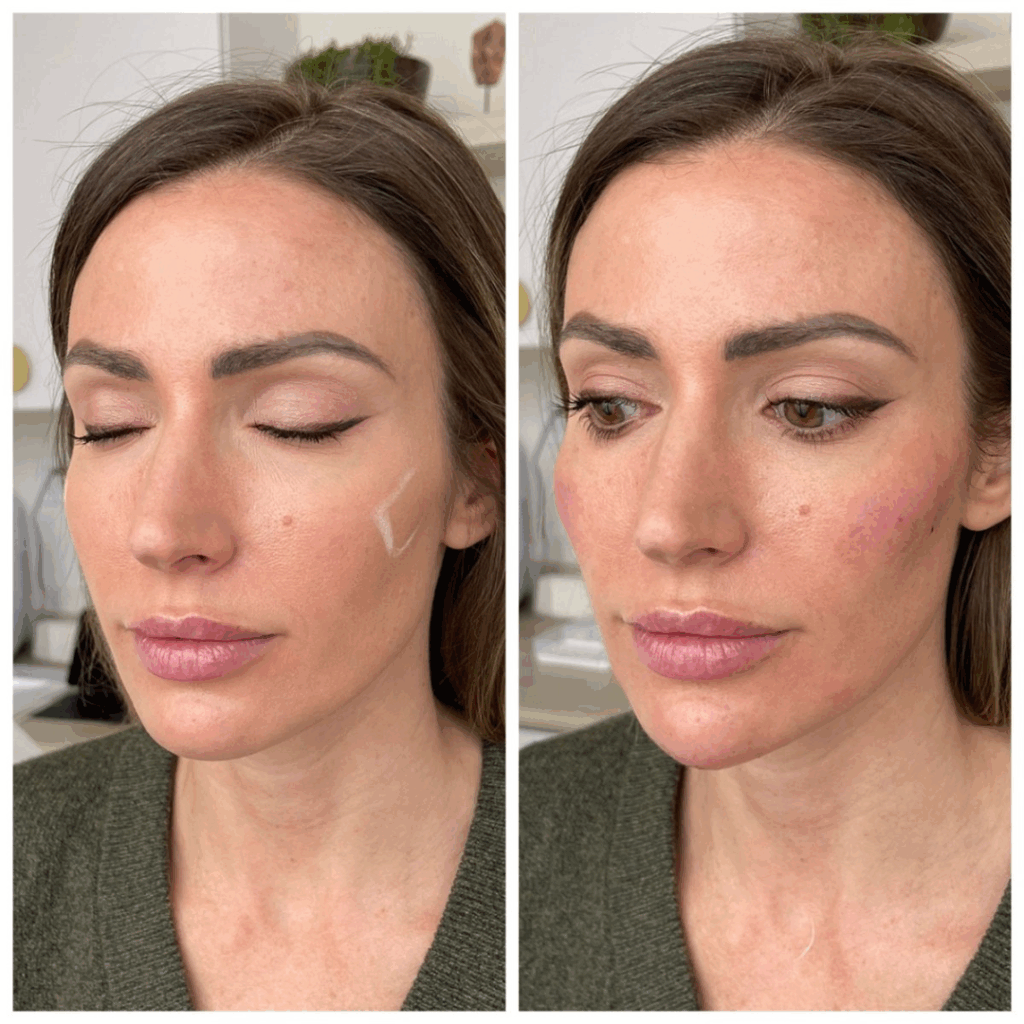Facial Balancing: The Subtle Art Behind Great Filler
If you’re tempted to book more lip filler but aren’t sure why something still feels “off” in the mirror, this might be the missing piece: facial balancing. It’s one of the most transformative yet misunderstood treatment approaches in aesthetics.
It truly takes a trained eye to know where to selectively add (or refrain from adding) filler—and once you find that person, it can transform the way you see your face.
Facial balancing is so subtle yet impactful that most people don’t realize they need it until they get it. And in this article, we’re breaking it down in granular detail.
What Is Facial Balancing?
Facial balancing is a tailored aesthetic approach that enhances overall harmony by looking at how your features work together—rather than focusing on a single “problem area” (as many people tend to do).
The goal is to create proportion, symmetry, and flow using a combination of dermal filler, neuromodulators like Botox or Dysport, and, in some cases, collagen-boosting treatments.

At The Luxe Room, we see facial balancing as the why behind your treatment—not just the what. Why do your lips feel “off” even though they’re full? Why does erasing nasolabial folds leave the face looking less natural? Every adjustment affects nearby structures—and, ultimately, your entire look. That’s why you need a trained eye to see the full picture and make everything work together in a way that still feels like you.
The secret? Knowing exactly where to place small amounts of product to shape how light moves across the face, support your natural structure, and bring your features into balance. It’s never about adding volume everywhere. As with everything we do at The Luxe Room, it comes down to knowing where less does more.
Why “Fixing the Feature” Isn’t Always the Fix
If you’re tempted to add more to a feature that feels “off,” chances are the real issue is coming from somewhere else. Most people focus on what they see in the mirror—but what you see isn’t always what needs fixing.
Take the lips. There are dips and hollows above and below them that can become more obvious when you make the lips bigger. Taking those areas into account and filling them in will give you lift, support, and the lip filler effect you’re after.
Another thing lots of patients miss—the profile. If your chin lacks definition, fuller lips can actually make it look even smaller. Unless you want to appear like you have a receding chin, lip filler is almost always followed by chin filler to balance the profile.
But most people won’t catch that—because we’re used to seeing ourselves front-on, not from the side.
Same goes for the under-eye area. Injecting directly into a hollow can sometimes leave you looking puffy or overfilled, when what you actually need is a bit of cheek support. A subtle tweak to the midface can lift the under-eye instantly—no direct filler required.
It’s all about strategy. That’s why it’s so important to trust your injector’s input. Getting isolated treatments here and there isn’t always the best move—because naturally, patients don’t always see what’s throwing the face off balance. That’s where expertise comes in.
What We’re Looking at During a Facial Balancing Assessment
It starts with a full-face assessment. Your injector evaluates facial proportions from all angles—not just straight on. They’re looking at bone structure, fat pads, symmetry, volume loss, muscle activity, and how the light moves across your face. Most people focus on one concern in the mirror, but your injector is seeing the entire map.
Supporting one area can lift another. Cheek volume loss often causes under-eye hollowness and deep smile lines. Adding subtle support to the midface can lift and refresh without ever touching those areas directly.
Light tells us where to treat. Shadowy dips or sharp transitions can make the face look tired. Adjusting how light reflects off your features—by filling small hollows or enhancing structure—can instantly create a more rested, harmonious look.
We’re not trying to erase everything. Features like nasolabial folds are part of human expression. The goal is to soften, not remove. Erasing too much often makes the face look flat or artificial.
Sometimes filler isn’t the answer. If the chin dimples when you speak or the jawline feels bulky, neuromodulators like Botox or Dysport may be the better option. They can slim, lift, or soften certain areas without adding any volume.
Less is better. Always. Most facial balancing plans use just 2.5 to 5 ml of filler total—that’s about half to a full teaspoon, or 3 to 5 blueberries if you prefer the visual. When placed strategically, that’s often enough to lift, balance, and refresh the whole face. You can always build more later, but you can’t always take it back.
Filler choice is strategic. Different parts of the face need different consistencies. Firmer products create structure in areas like the chin or jawline. Softer, more flexible options are better for lips or smile lines. Using the wrong product in the wrong spot can cause swelling, migration, or unnatural texture.

Key Areas Often Treated in Facial Balancing
Facial balancing is never one-size-fits-all. But there are a few areas that come up frequently—because they affect so much of the face’s overall symmetry and flow.
- Chin
The chin plays a bigger role in facial harmony than most people realize. A slightly recessed chin can make the nose look larger, lips appear fuller than intended, or the lower face feel undefined—especially from the side. Even a millimeter or two of projection can bring everything back into proportion. - Midface (cheeks)
The cheeks provide vertical lift and under-eye support. When done strategically, this area can restore freshness and smooth transitions—without touching the tear troughs directly. Soft, contour-friendly fillers work best here. - Jawline
Jawline contouring helps frame the face, tighten the appearance of skin, and offset fullness in the midface. Firmer, structural fillers are often used along the mandibular angle and body of the jaw to create clean definition. - Temples
Loss of volume here can subtly age the face. Treating the temples can lift the brow, soften the outer eye, and rebalance facial width—especially important in women or anyone seeking a more youthful upper-third contour. - Lips
Lip filler can be beautiful—but without surrounding support, it can make everything else feel off. Corners of the mouth, chin, philtrum, and even nasal structure should all be considered if you want the lips to “belong” on the face.
Facial Balancing Looks Different for Everyone. In women, facial balancing typically aims to enhance a heart- or oval-shaped structure. That means a slimmer, pointed chin, gentle curves through the cheeks, and soft contouring that lifts rather than adds bulk. The goal is flow—light should move smoothly across the face without getting caught on overly sharp edges or heavy volume.
In men, the opposite tends to apply. Masculine facial harmony usually calls for a squarer, more angular jawline, with a strong chin and flatter cheeks. We’re working to emphasize structure and strength, keeping the lower face broad and defined without softening key angles.
Ethnicity matters too. Certain ethnic groups naturally have more forward cheek projection, flatter midfaces, or heavier lower thirds—and each of these shifts the way we approach balance.
Tools Beyond Filler
Facial balancing doesn’t happen with filler alone. We age in multiple layers—skin, fat, bone, and muscle—so we need to treat all four if we want balance that actually lasts.
Botox or Dysport are essential for relaxing muscles that work against your filler. Think: a strong mentalis (chin), overactive masseters, or muscles pulling down the corners of your mouth. Without neuromodulators, those muscles will break down your filler faster and distort the shape. Relaxing them prevents that “tug-of-war” and helps your results settle naturally.
Sculptra and hyperdilute Radiesse are collagen stimulators. They don’t give instant volume—but over time, they build thickness and structure, especially in areas like the temples, jawline, and lower face where collagen loss is more generalized. Each treatment adds one to two millimeters of dermal thickness.
Then there’s skin tightening—RF microneedling, Moxi laser, or Clear + Brilliant. They firm the skin, improve elasticity, and reduce surface laxity. When layered with injectables, they can make your results look tighter, smoother, and more lifted—without overfilling.
This is why the best results come from a plan. Filler is one tool—but real facial balancing uses all four layers: skin, muscle, fat, and bone. You can’t fix multi-dimensional aging with a single approach.

How Much Does Facial Balancing Cost?
It varies a lot. It can be $1,500 or $5,000+—there’s really no way to put a number on it, and it would be silly to try. This is a completely personalized approach that usually involves multiple products, tailored to your face.
But if you’re on a budget and want to start with just one thing (instead of defaulting to more filler), try the Botox/Dysport approach—think facial slimming, taming overactive muscles, softening harsh movements. Small tweaks can shift your entire look.
Also? If you’re getting lip filler, pair it with chin filler—the two go hand in hand more often than people think. Your injector will already know what makes sense for your face.
The key is to talk through your budget with your injector and trust their trained eye. That’s where the real magic happens.
How to Choose the Right Injector
Facial balancing isn’t dramatic. The best work is subtle, refined, and almost undetectable. You shouldn’t be able to pinpoint what was done—just that everything looks more harmonious.
When choosing an injector, scroll through their before-and-afters. Do people still look like themselves? Are the results clean, natural, and balanced? That’s the mark of someone who understands facial proportions—not just how to inject. It takes a trained eye, a feel for nuance, and the confidence to leave certain areas untouched.
Not sure where to start? Book a free expert assessment—and take a look at our gallery while you’re here. It speaks for itself.



